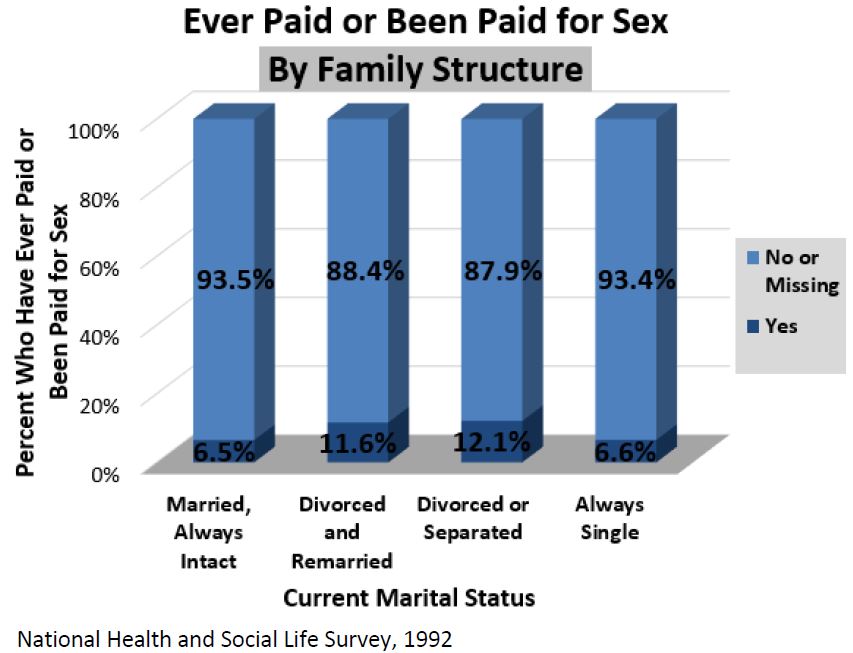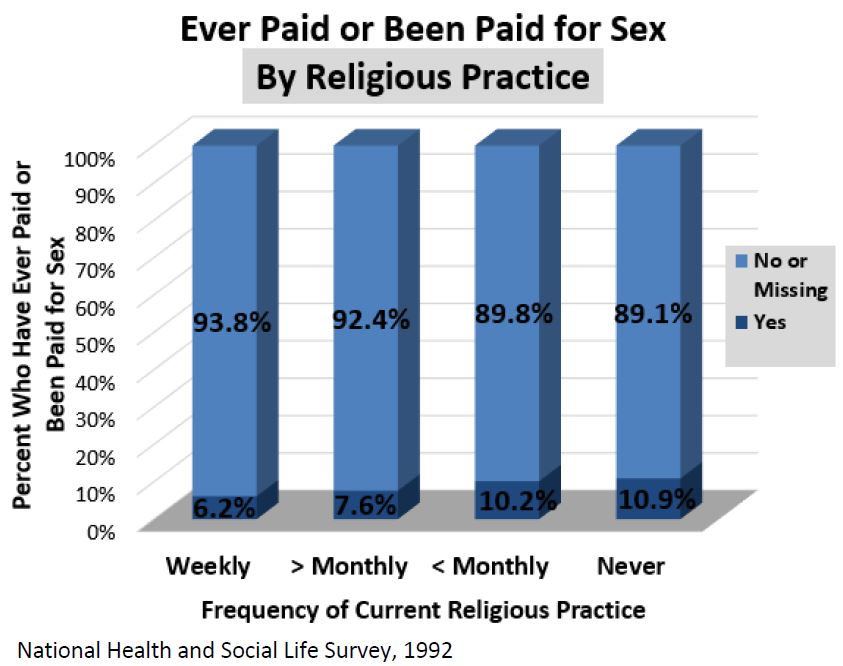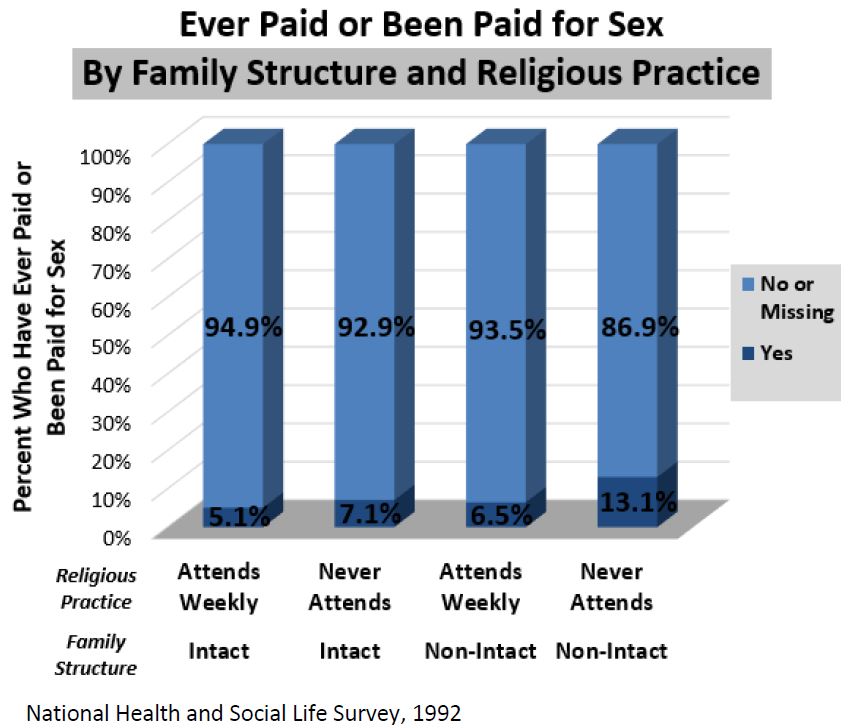Click Here to download “Has Ever Paid or Been Paid for Sex by Family Structure and Religious Practice”
Has Ever Paid or Been Paid for Sex by Family Structure and Religious Practice
The 1992 National Health and Social Life Survey shows that, of adults aged 18 to 59, those in intact marriages who worshipped weekly were least likely to have ever paid or been paid for sex.
[1]
Family Structure: Those in always-intact marriages were least likely to have ever paid or been paid for sex (6.5 percent), followed by those who were always single (6.6 percent), those who were divorced and remarried (11.6 percent), and those who were divorced or separated (12.1 percent).
 Religious Practice:
Religious Practice: Those who worshipped weekly at the time of the survey were least likely to have ever paid or been paid for sex (6.2 percent), followed by those who worshipped less than weekly but at least monthly (7.6 percent), those who worshipped less than monthly (10.2 percent), and those who never worshipped (10.9 percent).
 Family Structure and Religious Practice Combined:
Family Structure and Religious Practice Combined: Those in intact marriages who worshipped weekly were the least likely to have ever paid or been paid for sex (5.1 percent). Those in non-intact family structures and singles who worshipped weekly (6.5 percent) and those in intact marriages who never worshipped (7.1 percent) were slightly more likely to have ever paid or been paid for sex; however, those in non-intact family structures and singles who never worshipped were much more likely to have done so (13.1 percent).
 Related Insights from Other Studies:
Related Insights from Other Studies: Of a sample of over 400 Hispanic migrant workers in North Carolina, most of whom were Mexican, Honduran, and Salvadorian, those who were married and lived with their spouses were significantly less likely to have relations with a prostitute (5 percent) than single men (46 percent) or married men whose wives had remained in their country of origin (40 percent).
[2]
A study of HIV-1 prevalence among east African trucking company workers found that, of the cohort, a smaller percentage of Muslims had ever had relations with a prostitute (48 percent) than adherents to other religions (58 percent).
[3]
[1] These charts draw on data collected by the 1992 National Health and Social Life Survey
[2] Emilio A. Parrado, Chenoa A. Flippen, and Chris McQuiston, “Use of Commercial Sex Workers Among Hispanic Migrants In North Carolina: Implications for the Spread of HIV,”
Perspectives on Sexual and Reproductive Health 36, no. 4 (2004): 153.
[3] Joel Rakwar, Ludo Lavreys, Mary Lou Thompson, Denis Jackson, Job Bwayo, Salim Hassanali, Kishorchandra Mandaliya, Jeckoniah Ndinya-Achola, and Joan Kreiss, “Cofactors for the acquisition of HIV-1 among heterosexual men: prospective cohort study of trucking company workers in Kenya,”
AIDS 13 (1999): 609.]]>
 Religious Practice: Those who worshipped weekly at the time of the survey were least likely to have ever paid or been paid for sex (6.2 percent), followed by those who worshipped less than weekly but at least monthly (7.6 percent), those who worshipped less than monthly (10.2 percent), and those who never worshipped (10.9 percent).
Religious Practice: Those who worshipped weekly at the time of the survey were least likely to have ever paid or been paid for sex (6.2 percent), followed by those who worshipped less than weekly but at least monthly (7.6 percent), those who worshipped less than monthly (10.2 percent), and those who never worshipped (10.9 percent).
 Family Structure and Religious Practice Combined: Those in intact marriages who worshipped weekly were the least likely to have ever paid or been paid for sex (5.1 percent). Those in non-intact family structures and singles who worshipped weekly (6.5 percent) and those in intact marriages who never worshipped (7.1 percent) were slightly more likely to have ever paid or been paid for sex; however, those in non-intact family structures and singles who never worshipped were much more likely to have done so (13.1 percent).
Family Structure and Religious Practice Combined: Those in intact marriages who worshipped weekly were the least likely to have ever paid or been paid for sex (5.1 percent). Those in non-intact family structures and singles who worshipped weekly (6.5 percent) and those in intact marriages who never worshipped (7.1 percent) were slightly more likely to have ever paid or been paid for sex; however, those in non-intact family structures and singles who never worshipped were much more likely to have done so (13.1 percent).
 Related Insights from Other Studies: Of a sample of over 400 Hispanic migrant workers in North Carolina, most of whom were Mexican, Honduran, and Salvadorian, those who were married and lived with their spouses were significantly less likely to have relations with a prostitute (5 percent) than single men (46 percent) or married men whose wives had remained in their country of origin (40 percent).[2]
A study of HIV-1 prevalence among east African trucking company workers found that, of the cohort, a smaller percentage of Muslims had ever had relations with a prostitute (48 percent) than adherents to other religions (58 percent).[3]
[1] These charts draw on data collected by the 1992 National Health and Social Life Survey
[2] Emilio A. Parrado, Chenoa A. Flippen, and Chris McQuiston, “Use of Commercial Sex Workers Among Hispanic Migrants In North Carolina: Implications for the Spread of HIV,” Perspectives on Sexual and Reproductive Health 36, no. 4 (2004): 153.
[3] Joel Rakwar, Ludo Lavreys, Mary Lou Thompson, Denis Jackson, Job Bwayo, Salim Hassanali, Kishorchandra Mandaliya, Jeckoniah Ndinya-Achola, and Joan Kreiss, “Cofactors for the acquisition of HIV-1 among heterosexual men: prospective cohort study of trucking company workers in Kenya,” AIDS 13 (1999): 609.]]>
Related Insights from Other Studies: Of a sample of over 400 Hispanic migrant workers in North Carolina, most of whom were Mexican, Honduran, and Salvadorian, those who were married and lived with their spouses were significantly less likely to have relations with a prostitute (5 percent) than single men (46 percent) or married men whose wives had remained in their country of origin (40 percent).[2]
A study of HIV-1 prevalence among east African trucking company workers found that, of the cohort, a smaller percentage of Muslims had ever had relations with a prostitute (48 percent) than adherents to other religions (58 percent).[3]
[1] These charts draw on data collected by the 1992 National Health and Social Life Survey
[2] Emilio A. Parrado, Chenoa A. Flippen, and Chris McQuiston, “Use of Commercial Sex Workers Among Hispanic Migrants In North Carolina: Implications for the Spread of HIV,” Perspectives on Sexual and Reproductive Health 36, no. 4 (2004): 153.
[3] Joel Rakwar, Ludo Lavreys, Mary Lou Thompson, Denis Jackson, Job Bwayo, Salim Hassanali, Kishorchandra Mandaliya, Jeckoniah Ndinya-Achola, and Joan Kreiss, “Cofactors for the acquisition of HIV-1 among heterosexual men: prospective cohort study of trucking company workers in Kenya,” AIDS 13 (1999): 609.]]>
